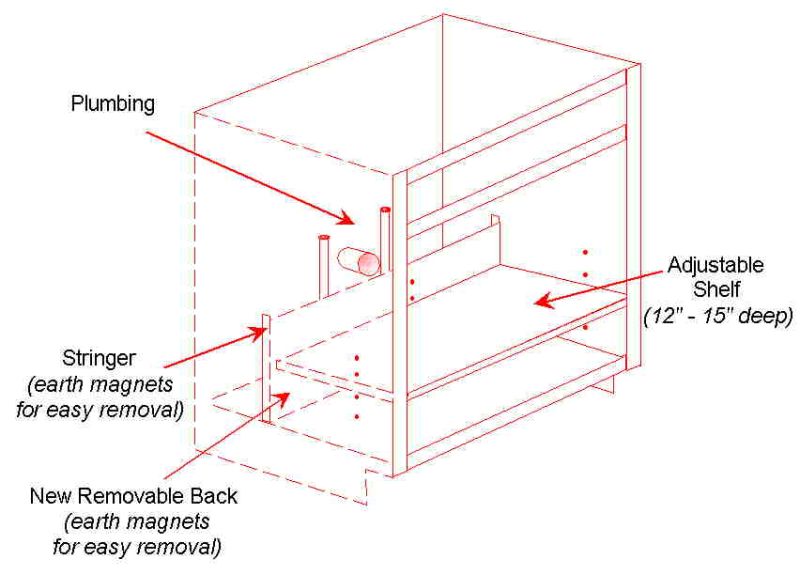Patching a Plumbing Hole Drilled by Mistake
Two extra holes in a sink cabinet bottom ... and 10 good ideas for fixing or hiding them. December 2, 2010
Question
Ok after eight years of careful measuring, I drilled the holes in the bottom of the sink cabinet in the wrong place, about 1 1/2" off. I was talking to the homeowner and read the the wrong side of the framing square. The kitchen had to go in with the extra holes. Now, how is the best way to fix my mistake in the 3/4" prefinished birch plywood? The bottom sits in a dado and the back stapled. I canít completely replace the bottom without a complete cabinet tear out. What is the best least noticed way to cover my mistake?
Forum Responses
(Cabinetmaking Forum)
From contributor R:
Sounds like it might be too big for a Fastcap drain trim, but you can put a piece of 1/4" of prefinished over it.
From contributor M:
Use a grommet to cover an extra hole, just silicone it in since it's under sink. The fact that you're bringing this problem here makes me think you're either way over thinking this or have a really picky client; most people understand that humans make mistakes and would be fine with a small panel to cover it up or filling it in plugs cut the shape of the mistake. If the client is really the picky and concerned about it I would run whatever you plan on doing by them first - hopefully you'll find out replacing the entire deck isn't the only repair they're willing to accept, and avoid having them call you out on what they consider a crappy job due to your repair. After all, it is just a sink base.
From contributor J:
How about running a 3/8 rabbit bit around the hole 3/8" deep, use a hole saw or circle cutter in drill press to make a plug to the outer diameter, run your rabbiting bit around the bottom side of the plug to match the depth, fill the center hole from drill bit (hole saw or circle cutter) a small piece of dowel, a little glue and what hole.
You can adjust this idea to match the thickness of the material if it's other than 3/4" and providing you can get a router inside the cabinet with the back attached. This also works great to hide one of those Mocket pull out receptacles just add a thumbnail gouge on the edge.
From contributor K:
If you don't have the room to add 1/4" ply, make a step-up shelf to make it easy to reach for the items in the back, which will also cover the hole. Another option is to add a false back with earth magnets (for easy removal) and add an adjustable shelf (see drawing below). This depends on the location of the plumbing of course, but you can also put in a "surround" around the plumbing which leaves room to the left and right of the plumbing. For picky customers, they love hiding most of the plumbing.

Click here for higher quality, full size image
From contributor T:
Since it is prefinished birch you can probably get a laminate that is very close match. Cut it to fit the bottom of the cabinet. A little contact adhesive and youíre done.
From contributor F:
I've used laminate to fix a similar mistake in the past and it works great. It matches the pre-finished well, it's more durable, and it's thin enough that most people will never notice it.
The comments below were added after this Forum discussion was archived as a Knowledge Base article (add your comment).
Comment from contributor A:
A few years ago, a customer asked me to plug a hole one of the other contractors had mistakenly made in the oak flooring next to the fire place. When done, the repair was noticeable only if you looked for it. In the case of my repair, there was old floor to back the hole and hold the plug in place. If not, I would have treated it like a drywall repair and glued a strip on the underside (just hold it in place until the glue dries).
To make the oak plug to match the hole (I had enlarged with a hole saw bit), I cut one just over-sized on the band saw, then sanded it to size on site (the closer the fit, the less noticeable the repair).
It shouldn't be too terribly difficult to find a scrap piece to match the material being plugged. The ring will always be there, but, again, careful fitting will keep the lines to a minimum.
